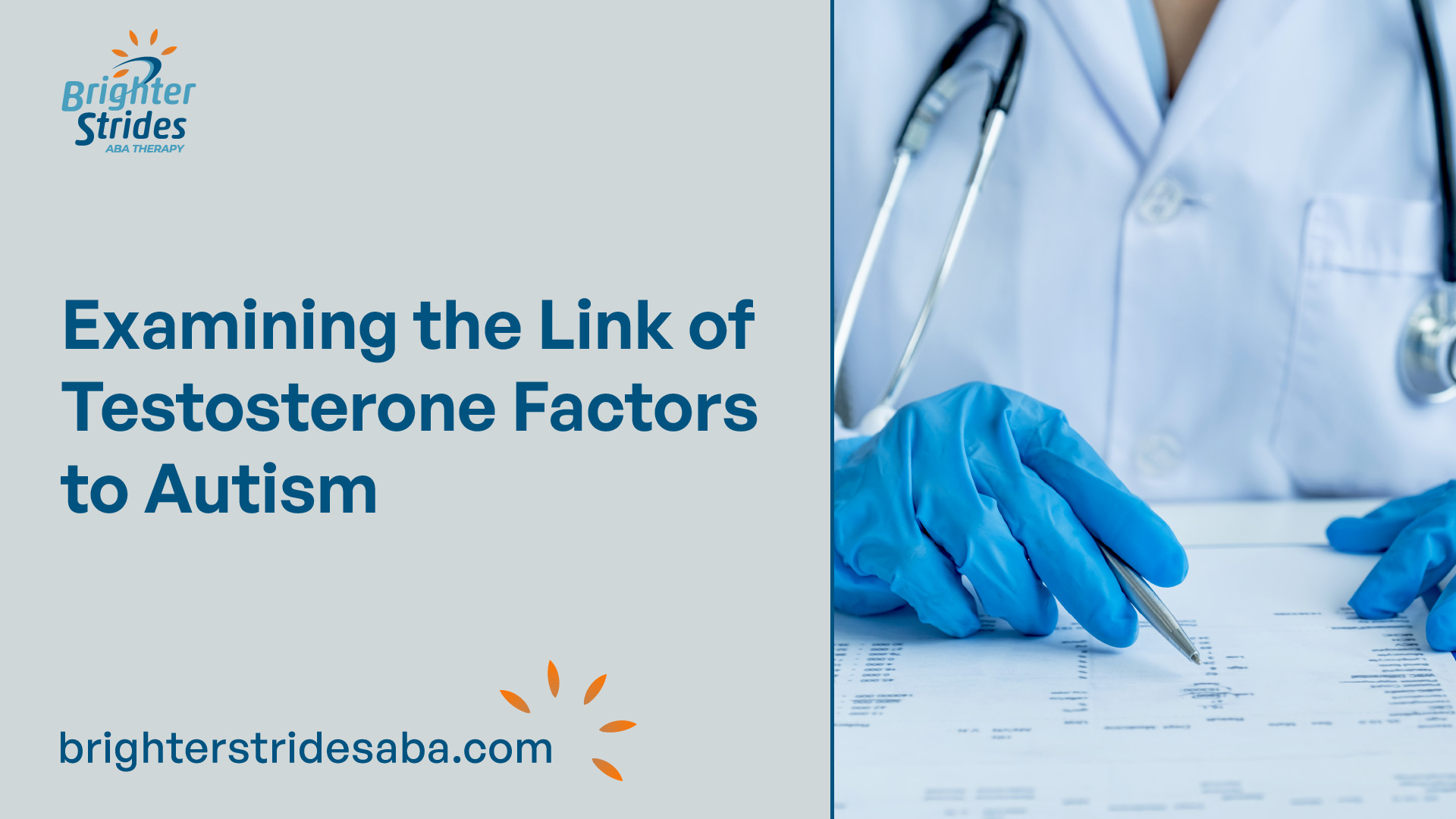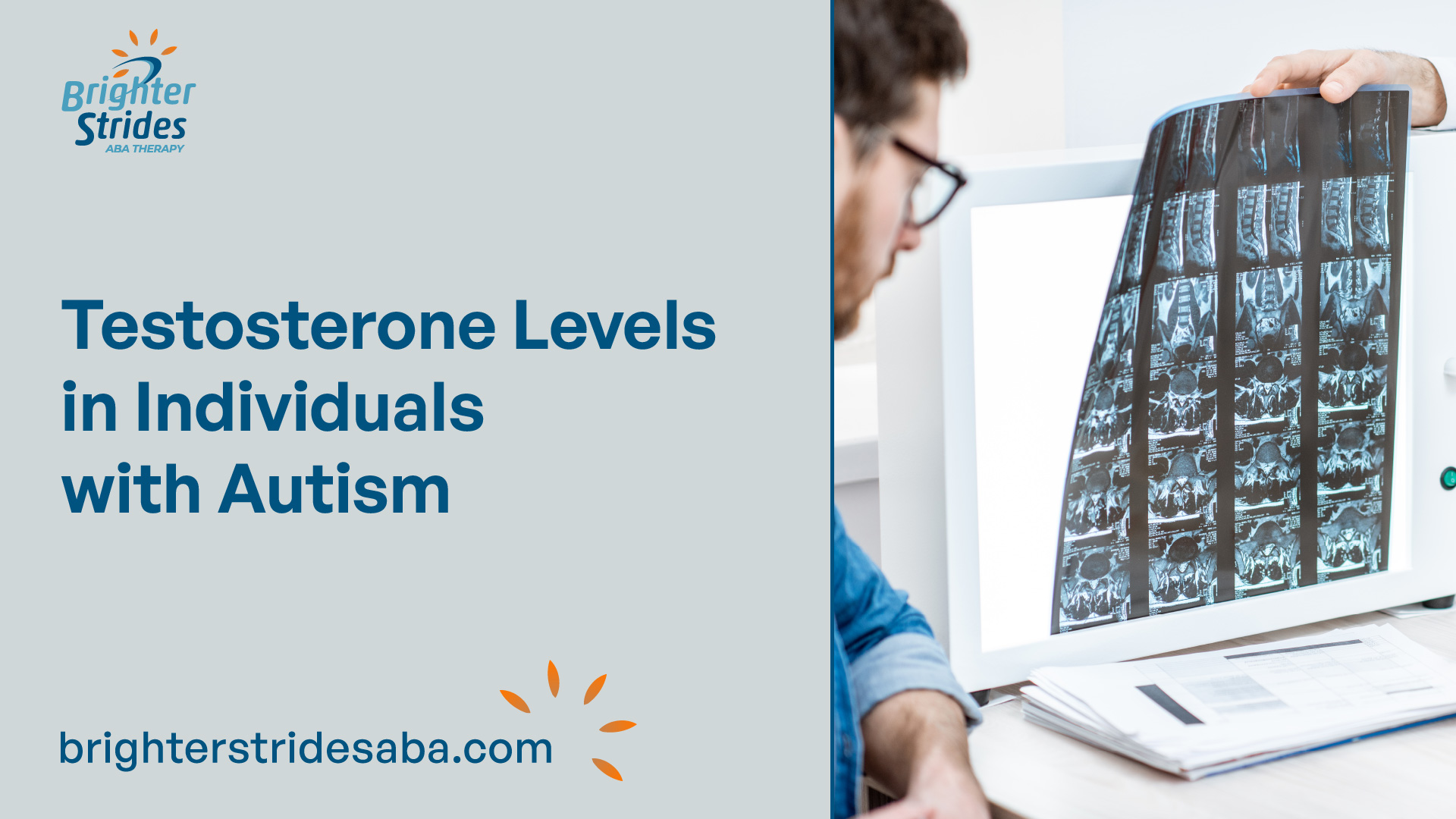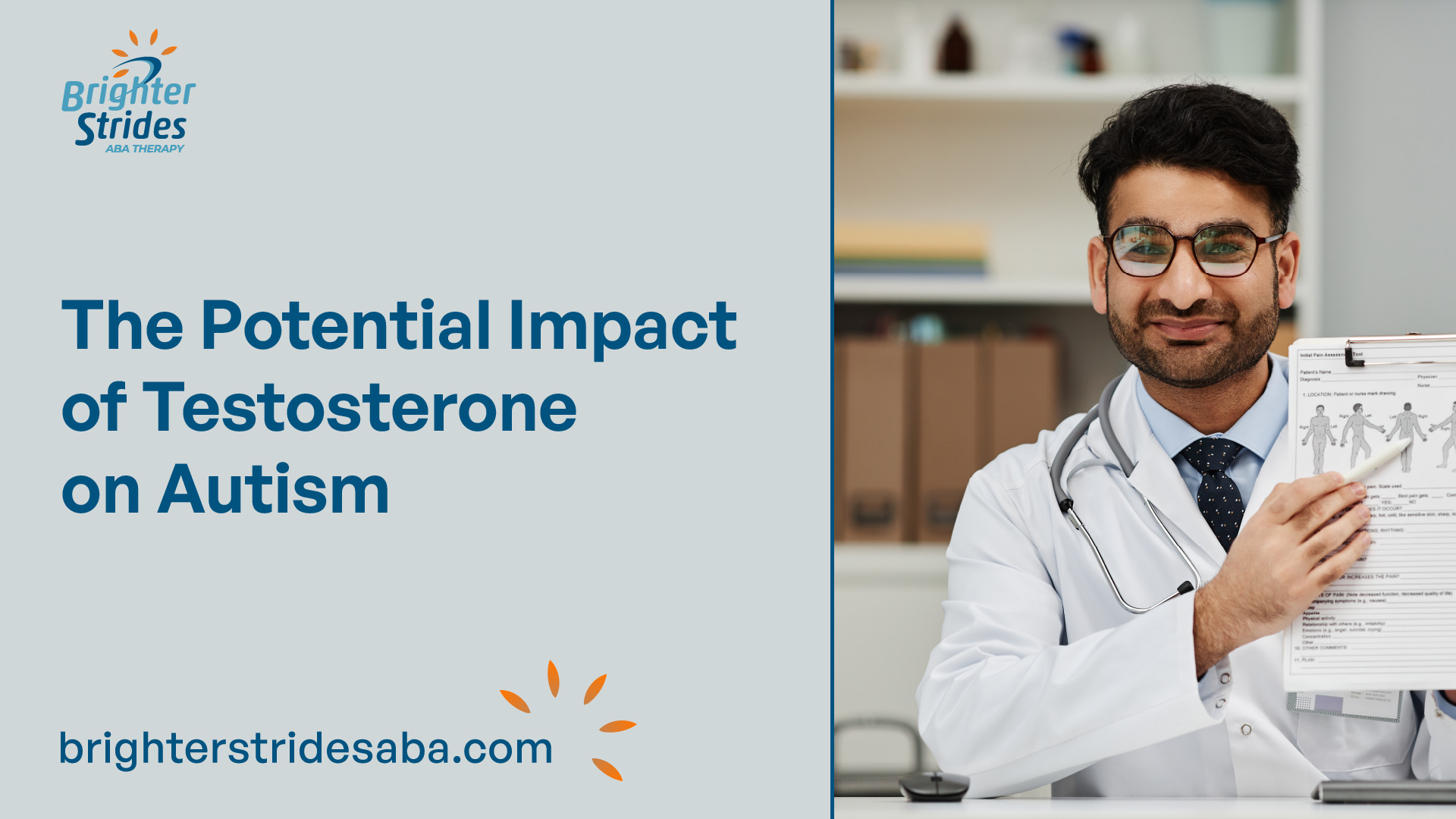Autism and Testosterone: Exploring the Link
To better understand the potential connection between autism and testosterone, it is important to delve into the characteristics of autism spectrum disorder (ASD) and the role that testosterone plays in the body.

Understanding Autism Spectrum Disorder
Autism spectrum disorder is a neurodevelopmental condition characterized by difficulties in social interaction, communication, and repetitive patterns of behavior. It affects approximately 1 in 59 children in the United States, with a higher prevalence in boys than girls. The exact cause of autism is still unknown, but researchers continue to explore various factors that may contribute to its development.
The Role of Testosterone in the Body
Testosterone, a hormone primarily produced in the testes in males and in smaller amounts in the ovaries and adrenal glands in females, plays a significant role in sexual dimorphism and the sexual differentiation of behavior and specific brain areas during prenatal development. It has organizational effects during the prenatal period, leading to permanent changes in the wiring and sensitivity of brain areas, which are largely irreversible.
Testosterone influences various aspects of development, including the formation of male genitalia and secondary sexual characteristics during puberty. It also affects cognitive processes, spatial abilities, and behaviors associated with aggression and dominance. Structural sex differences in the human brain, such as brain volume and cortical thickness, have been observed between males and females.
While testosterone is typically associated with male development, it is present in both males and females. It is important to note that testosterone levels can vary among individuals and within different stages of development.
Understanding the role of testosterone in the body provides a foundation for exploring its potential link to autism. Researchers are actively investigating the relationship between testosterone levels and autism, particularly focusing on prenatal testosterone exposure and its impact on brain development and the manifestation of autism symptoms. However, it is crucial to approach this topic with caution and recognize that correlation does not equal causation. Further research is needed to fully comprehend the complex relationship between autism and testosterone, as well as the potential involvement of other hormones beyond testosterone in individuals with autism.

Testosterone Levels in Individuals with Autism
Understanding the relationship between testosterone levels and autism is an important area of research. In this section, we will explore the testosterone levels in individuals with autism, including elevated testosterone in youth with ASD, testosterone variations during adolescence, and gender differences in testosterone levels.
Elevated Testosterone in Youth with ASD
Research has shown that youth with autism spectrum disorder (ASD) exhibit significantly elevated testosterone concentrations compared to their typically developing peers. This finding suggests that higher levels of testosterone may be associated with the development and manifestation of autism symptoms. However, it’s crucial to note that correlation does not imply causation, and further research is needed to understand the exact nature of this link.
Testosterone Variations during Adolescence
During adolescence, testosterone levels undergo significant changes in both individuals with and without autism. At younger ages, females tend to have higher testosterone compared to males. However, around 11.5 years of age, testosterone levels begin to plateau in females, while males continue to experience a rapid increase in testosterone concentrations, surpassing the levels of females. These variations in testosterone levels during adolescence may contribute to the differences in autism prevalence between boys and girls.
Gender Differences in Testosterone Levels
Autism affects approximately 1 in 59 children in the United States, with a higher prevalence in boys than girls. Research has indicated that individuals with autism may have abnormal levels of hormones beyond testosterone, such as higher cortisol levels and lower oxytocin levels, which can impact stress responses, social interaction, and emotional regulation. While most studies have focused on the link between high levels of testosterone and autism, some research suggests that men with autism may actually have lower levels of testosterone than neurotypical men. This indicates a potential complex relationship between autism and testosterone levels, requiring further investigation.
Understanding the testosterone levels in individuals with autism is essential for unraveling the potential impact of hormones on the development and symptoms of autism. While research has provided insights into elevated testosterone in youth with ASD and variations in testosterone during adolescence, there is still much to explore regarding the intricate relationship between autism and testosterone. Further studies will contribute to a deeper understanding of the link between testosterone and autism, potentially leading to improved diagnostic and therapeutic approaches for individuals on the autism spectrum.

The Potential Impact of Testosterone on Autism
Understanding the potential impact of testosterone on autism is a complex and ongoing area of research. While a link between testosterone and autism has been explored, it’s important to note that correlation does not equal causation. In this section, we will delve into the potential impact of testosterone on autism, focusing on prenatal testosterone exposure and its correlation with autism, as well as the potential effects of testosterone on autistic traits.
Prenatal Testosterone Exposure and Brain Development
Researchers have theorized that higher levels of prenatal testosterone exposure may affect brain development and contribute to the development of autism. During the prenatal period, there is a surge of testosterone in male fetuses between the 16th and 24th week of gestation. This surge mediates the organizational effect of testosterone on the brain, leading to permanent changes in the wiring and sensitivity of brain areas.
The organizational effects of testosterone during prenatal development play a significant role in shaping the brain. These effects are largely irreversible and can influence various aspects of brain structure and function. However, it’s important to note that the precise mechanisms through which testosterone influences brain development in relation to autism are still being investigated.
Correlation between Prenatal Testosterone and Autism
Numerous studies have found a correlation between higher levels of prenatal testosterone exposure and an increased risk of developing autism. However, it is crucial to highlight that correlation does not imply causation. The relationship between testosterone and autism is complex and multifaceted, with various genetic and environmental factors also playing a role in the development of autism.
While the correlation between prenatal testosterone and autism exists, further research is needed to understand the underlying mechanisms and the extent of testosterone’s contribution to the development of autism.
Potential Effects of Testosterone on Autistic Traits
The potential effects of testosterone on autistic traits are still being explored. Testosterone is known to influence various aspects of brain development and behavior, and it may contribute to the manifestation of certain autistic traits. However, the relationship between testosterone and autistic traits is complex and not yet fully understood.
The effects of testosterone on behavior and cognition can vary among individuals, and it is important to consider the interplay of other factors in the development of autism. Hormonal imbalances, including variations in testosterone levels, are believed to be potential contributing factors to the development of autism. Further research is necessary to unravel the intricate connections between testosterone and autistic traits.
Understanding the potential impact of testosterone on autism requires ongoing research and exploration. While prenatal testosterone exposure and its correlation with autism have been studied, it is important to approach the topic with caution and acknowledge the complexity of the relationship. Continued scientific investigations will contribute to a deeper understanding of the intricate interplay between testosterone and autism.
Hormonal Imbalances and Autism
While much of the focus on the link between autism and hormones has been on testosterone, there is evidence to suggest that individuals with autism may have abnormal levels of other hormones beyond testosterone. These hormonal imbalances can play a role in various aspects of autism spectrum disorder (ASD), including stress responses, social interaction, and emotional regulation.
Other Hormones and Their Effects on Autism
Research has indicated that individuals with autism may have abnormal levels of other hormones, such as higher cortisol levels and lower oxytocin levels, which can impact stress responses, social interaction, and emotional regulation. Cortisol is a hormone released in response to stress, and higher levels of cortisol can contribute to increased anxiety and difficulties in coping with stress. On the other hand, oxytocin, often referred to as the “love hormone,” plays a crucial role in social bonding and trust. Lower levels of oxytocin can affect social interaction and emotional connection.
Abnormal Hormone Levels Beyond Testosterone
In addition to cortisol and oxytocin, other hormones have been implicated in the hormonal imbalances observed in individuals with autism. For example, some studies have found variations in estrogen and progesterone levels in individuals with autism, although the findings are not consistent across all studies. These sex hormones play important roles in various aspects of development, including brain development and behavior.
It is important to note that the research on hormonal imbalances and autism is still evolving, and the findings are not yet conclusive. While some studies have found associations between abnormal hormone levels and autism, other studies have not replicated these findings. The complex nature of autism and the interplay of various factors make it challenging to establish a clear and consistent relationship between hormone levels and autism.
Further research is needed to better understand the role of hormones in autism and how these imbalances may contribute to the development and characteristics of the disorder. By gaining a deeper understanding of the hormonal factors involved, researchers and healthcare professionals can potentially develop more targeted interventions and treatments to support individuals with autism.
Limitations and Further Research
While research has shed light on the potential link between autism and testosterone, there are several limitations and areas for further investigation. It is important to approach the relationship between autism and testosterone with caution and recognize the complexity of this topic.
Correlation vs. Causation
Studies have shown a correlation between higher levels of prenatal testosterone exposure and an increased risk of developing autism. However, it is crucial to note that correlation does not necessarily imply causation. While the correlation suggests a potential link, it does not establish a direct cause-and-effect relationship between testosterone and autism. Further research is needed to uncover the underlying mechanisms and determine the causal nature of this association.
Inconsistencies in Testosterone Levels
Regarding testosterone levels in individuals with autism, there have been some inconsistencies in the findings. Some studies have suggested that men with autism may have lower levels of testosterone compared to neurotypical men. However, there is variability among the research findings, and more comprehensive studies are required to provide a clearer understanding of testosterone levels in individuals with autism. Additional factors such as age, sex, and pubertal timing may influence testosterone levels and should be considered in future investigations.
The Complex Relationship between Autism and Testosterone
The relationship between autism and testosterone is multifaceted and not yet fully understood. It is likely that multiple factors contribute to the development of autism, and testosterone may play a role in certain cases. However, the exact nature of this relationship, including the specific mechanisms and the extent of testosterone’s influence, requires further exploration.
Researchers have theorized that high levels of prenatal testosterone exposure may affect brain development and lead to autism. However, the effects of testosterone on brain structure and function may be altered during adolescence, and there may be interactions between prenatal testosterone and pubertal testosterone on brain function. These complexities highlight the need for more comprehensive and longitudinal studies to uncover the nuances of the relationship between autism and testosterone.
Understanding the limitations and complexities of studying the link between autism and testosterone is crucial for future research. Further investigations should aim to address these limitations, explore potential confounding variables, and delve deeper into the intricate mechanisms underlying the relationship between testosterone and autism. By doing so, we can enhance our understanding of autism and potentially develop more targeted interventions and treatments in the future.





